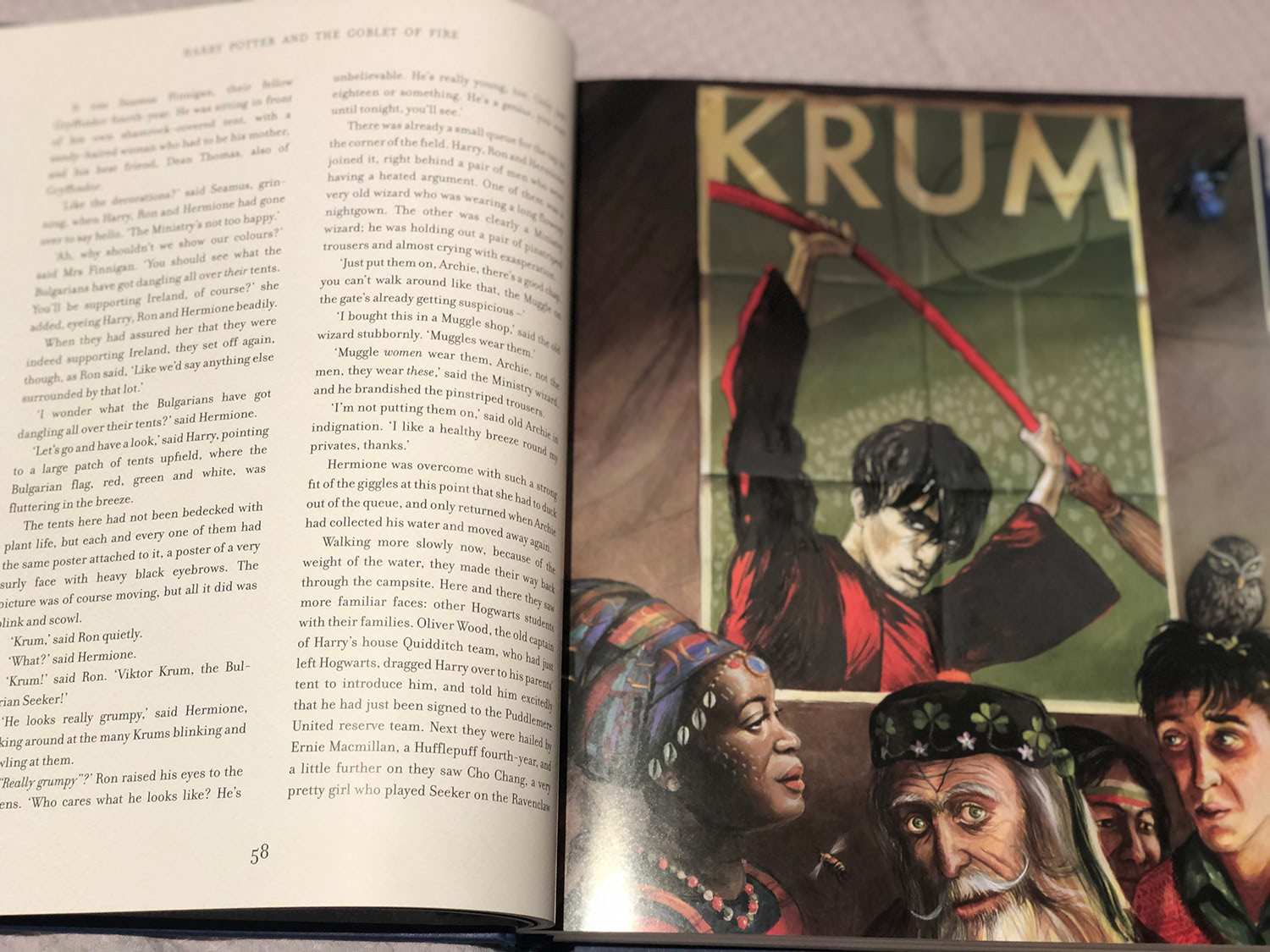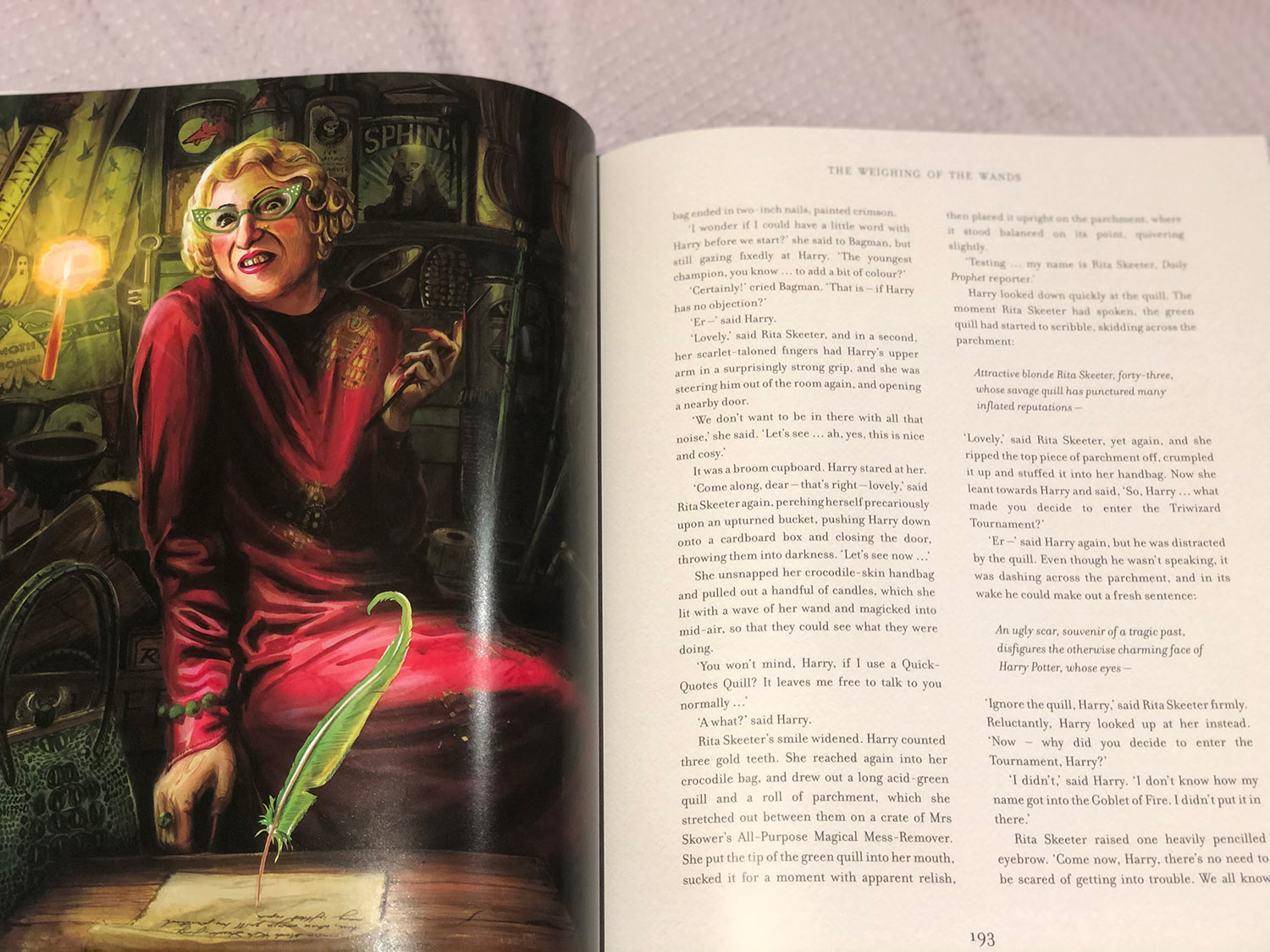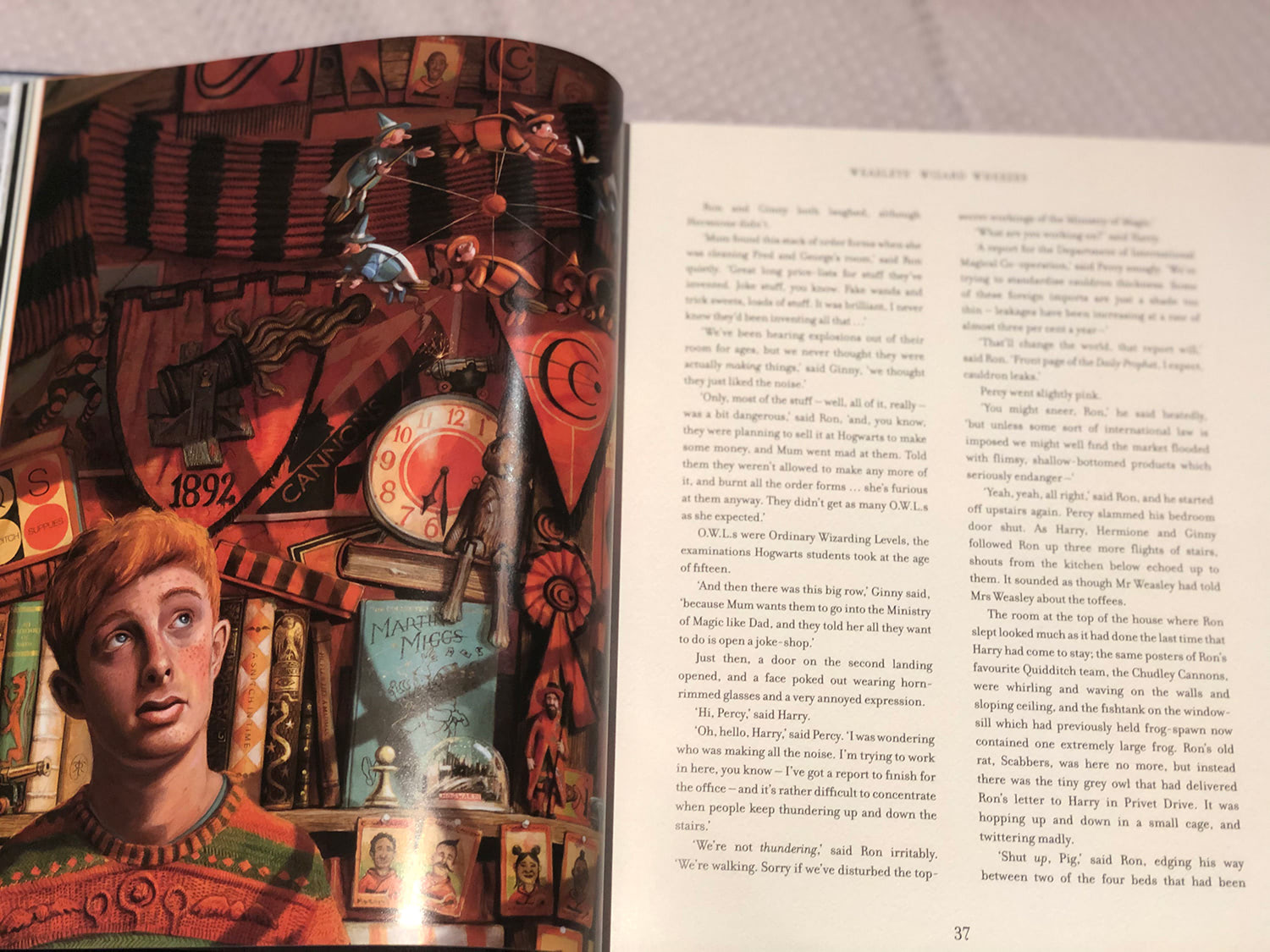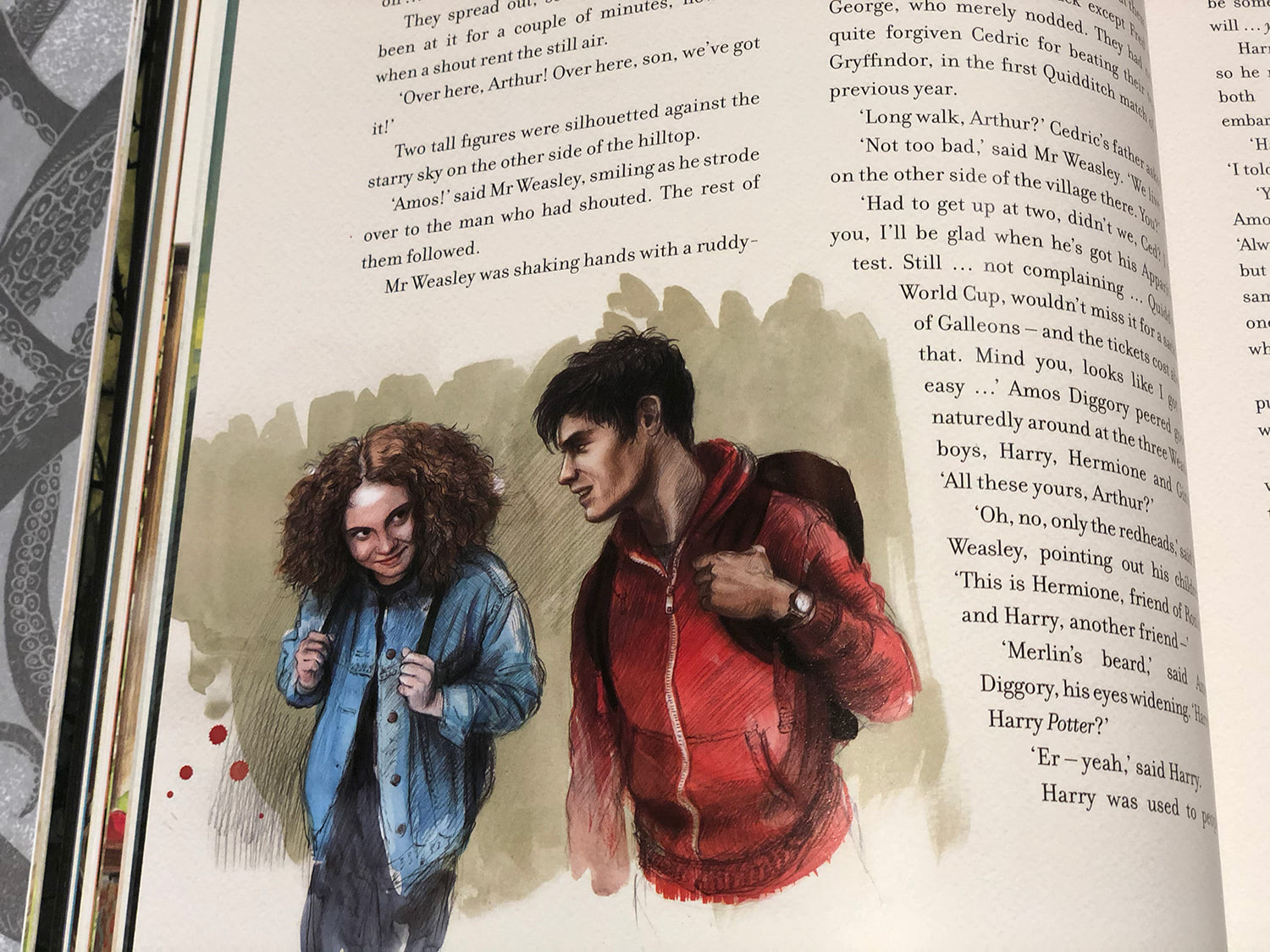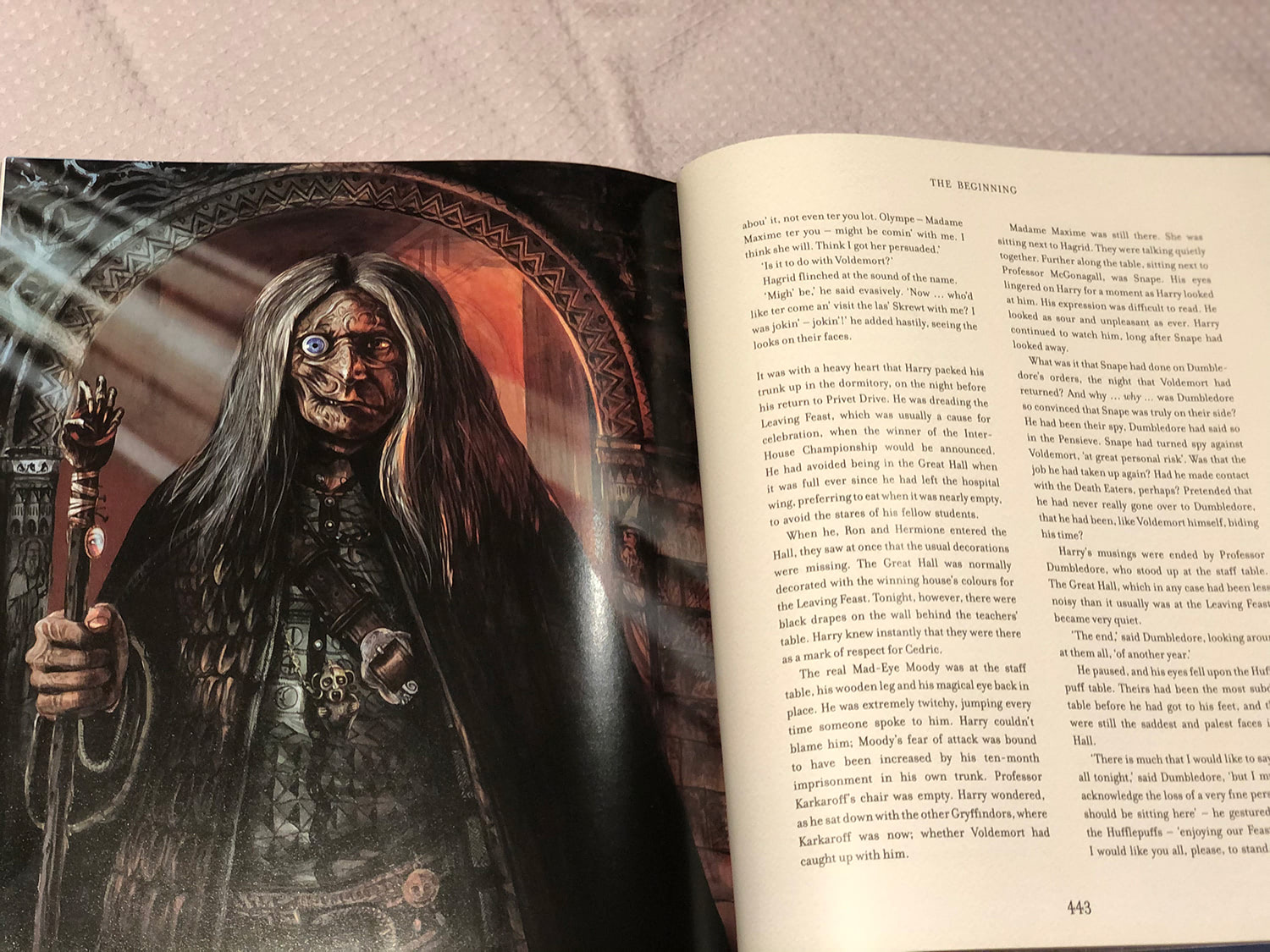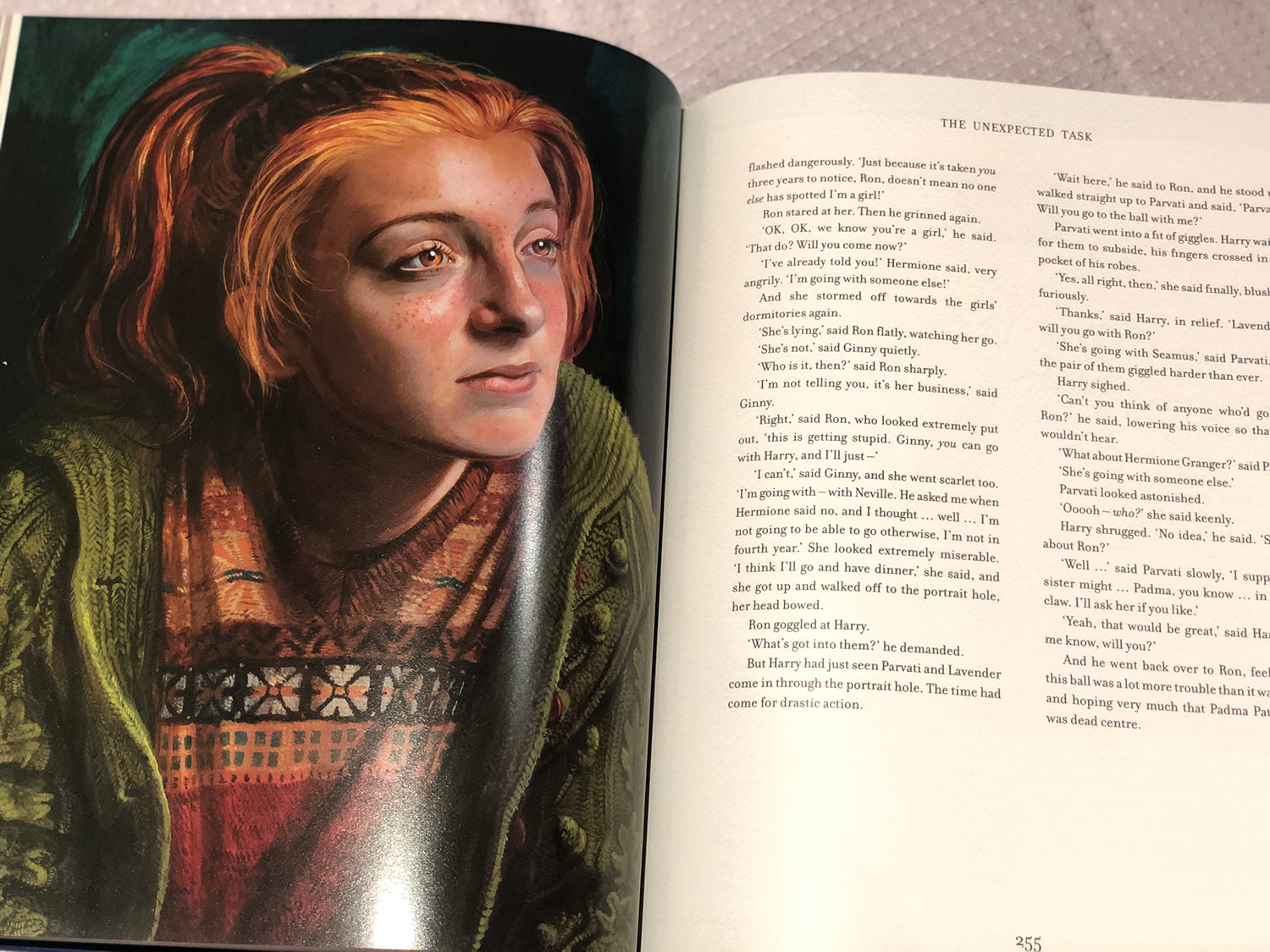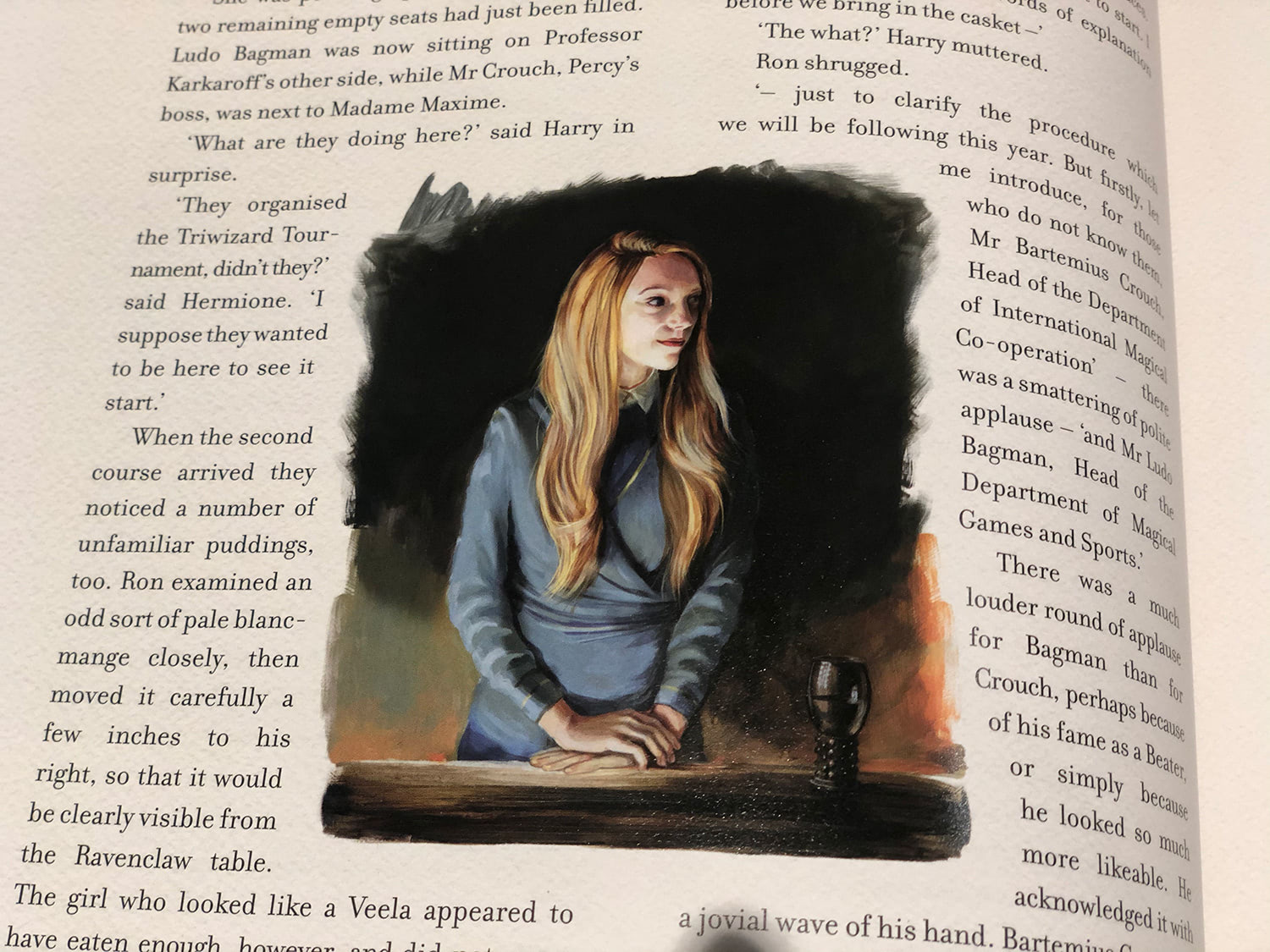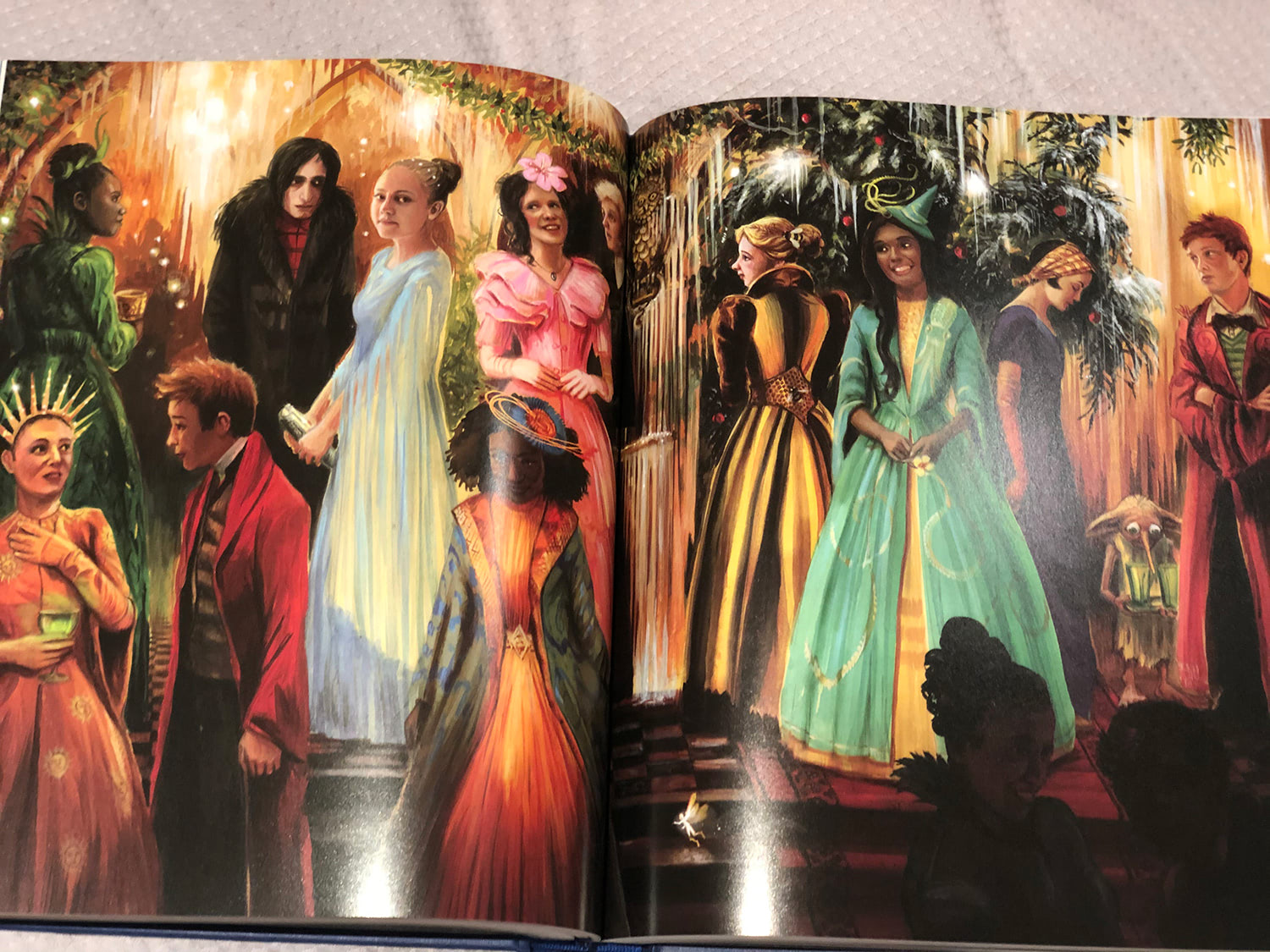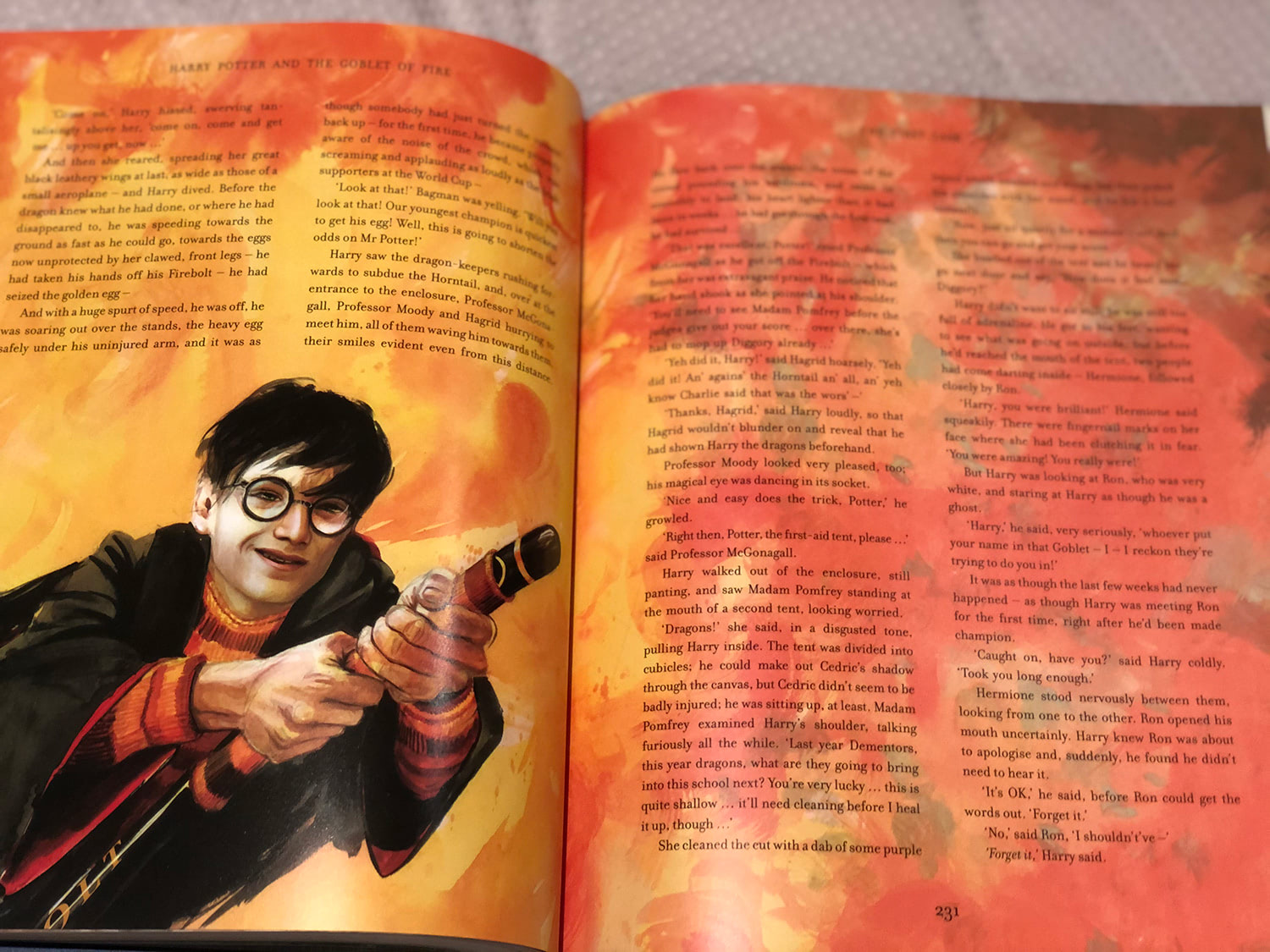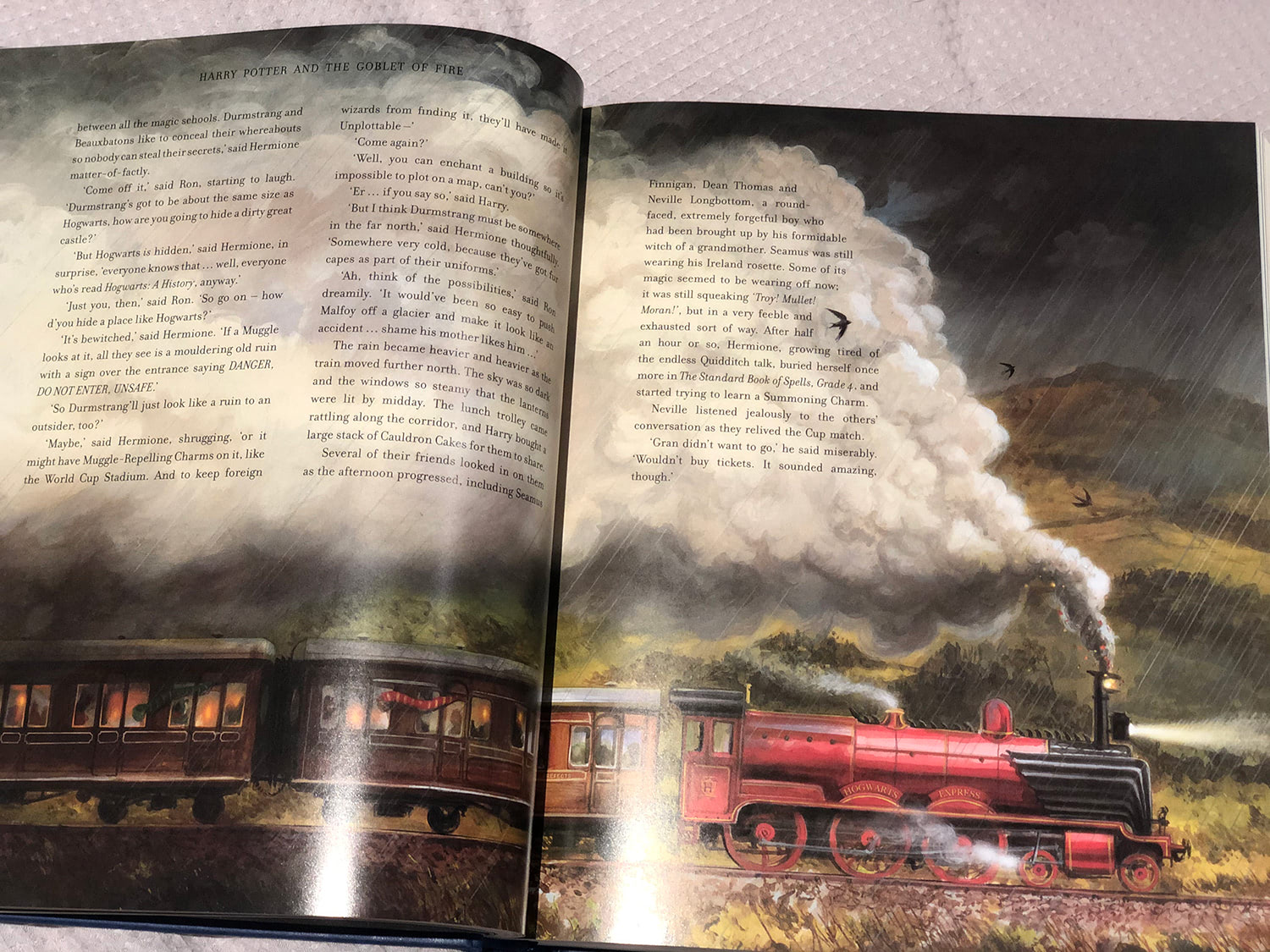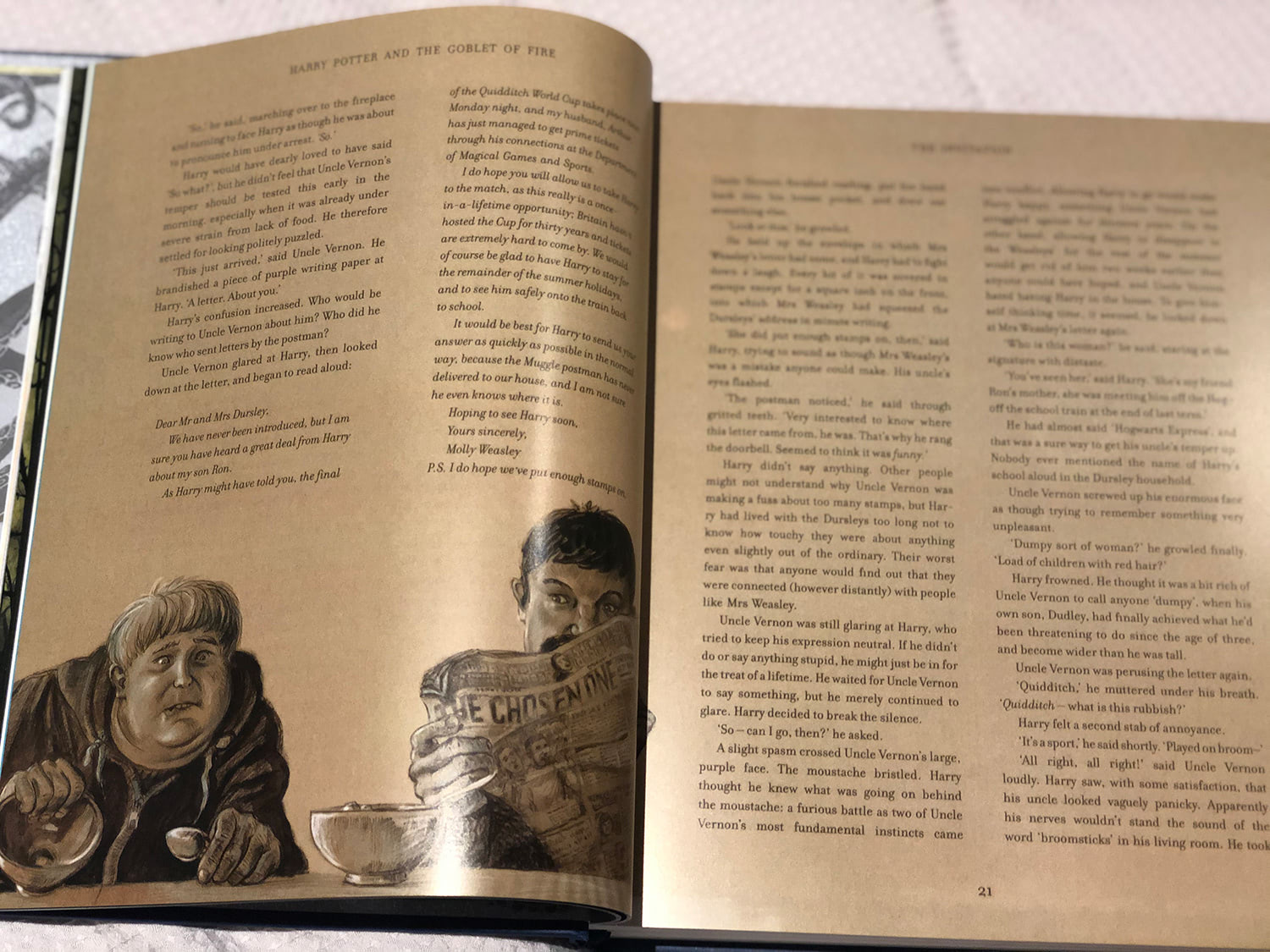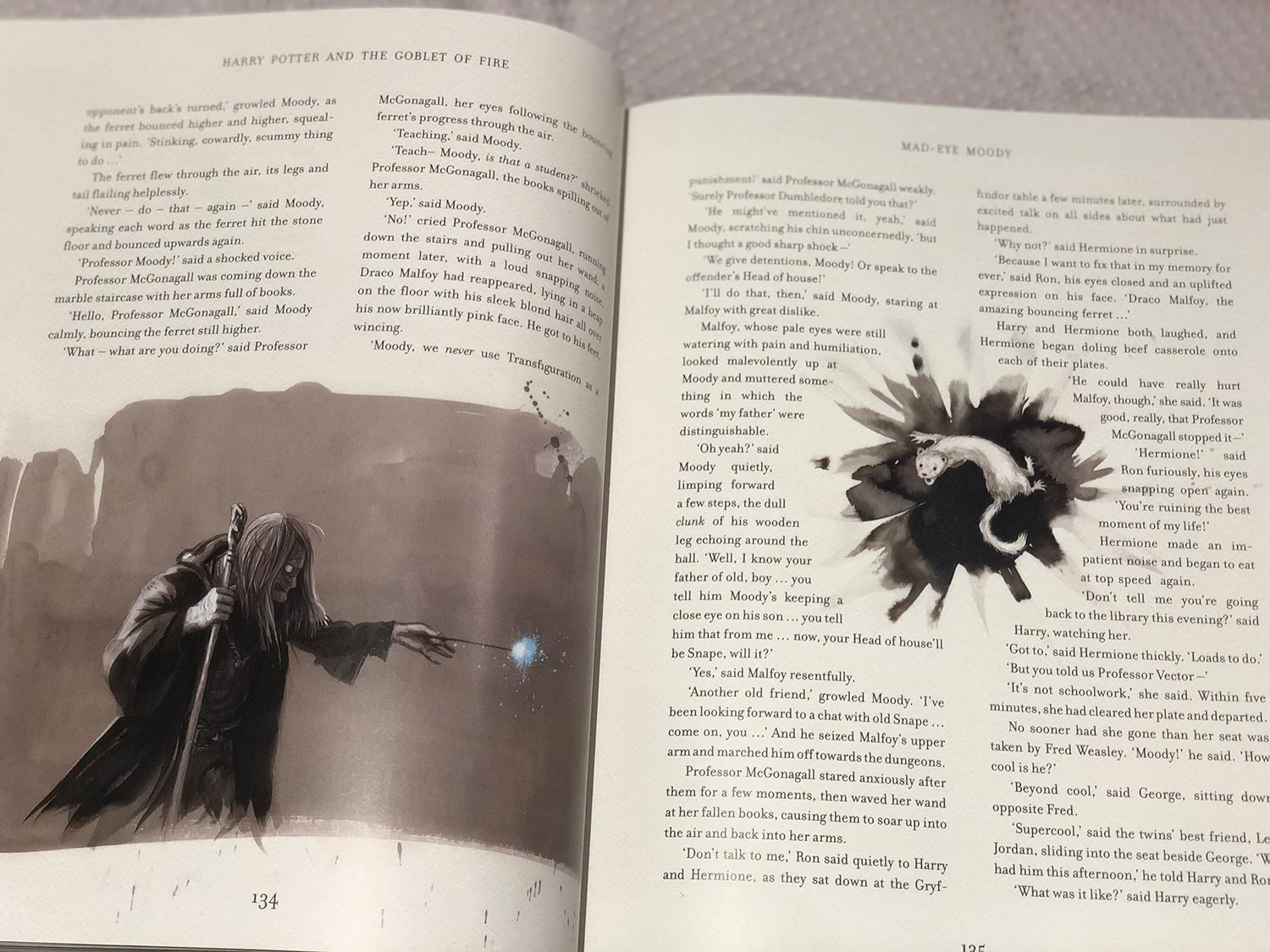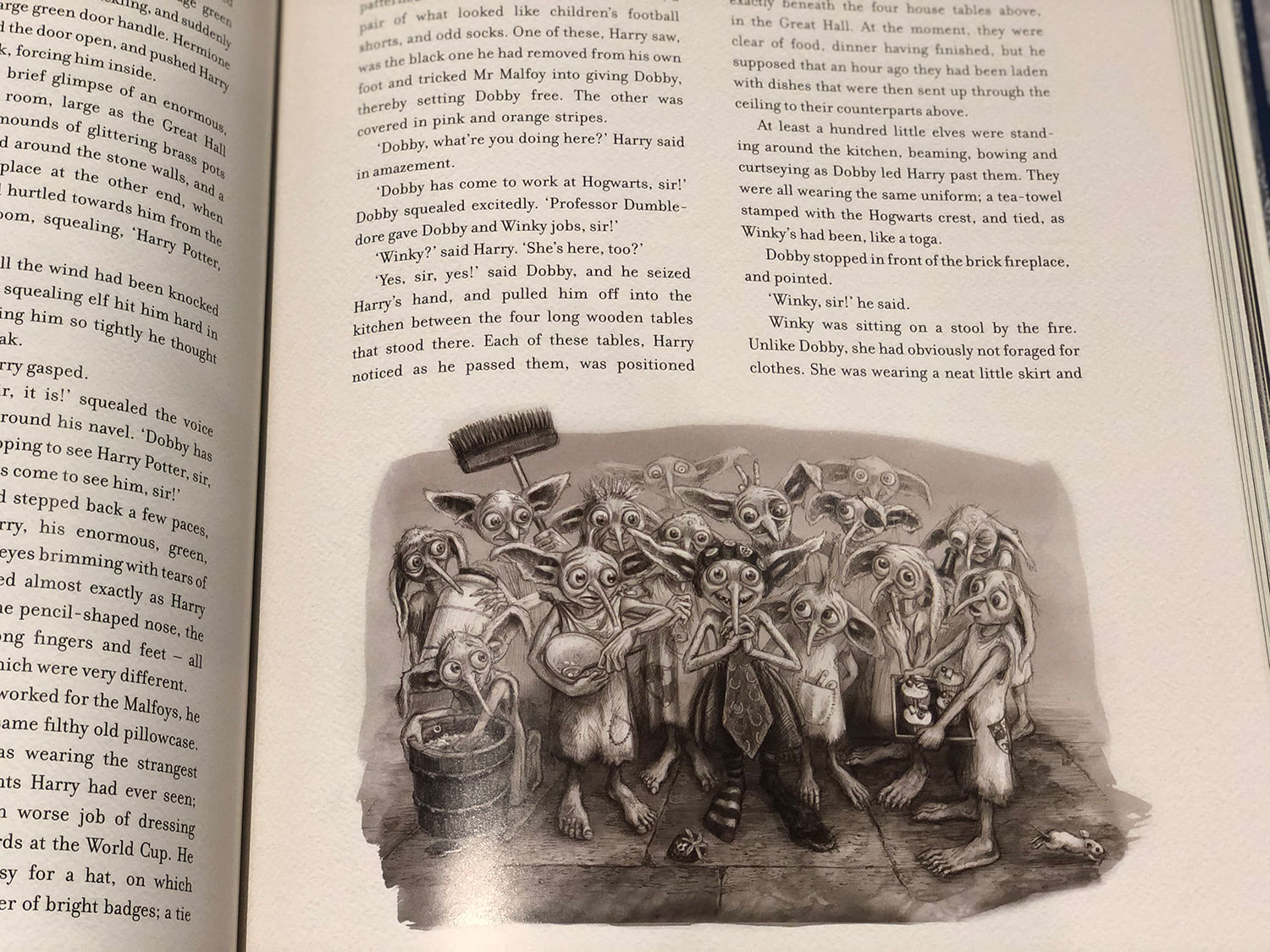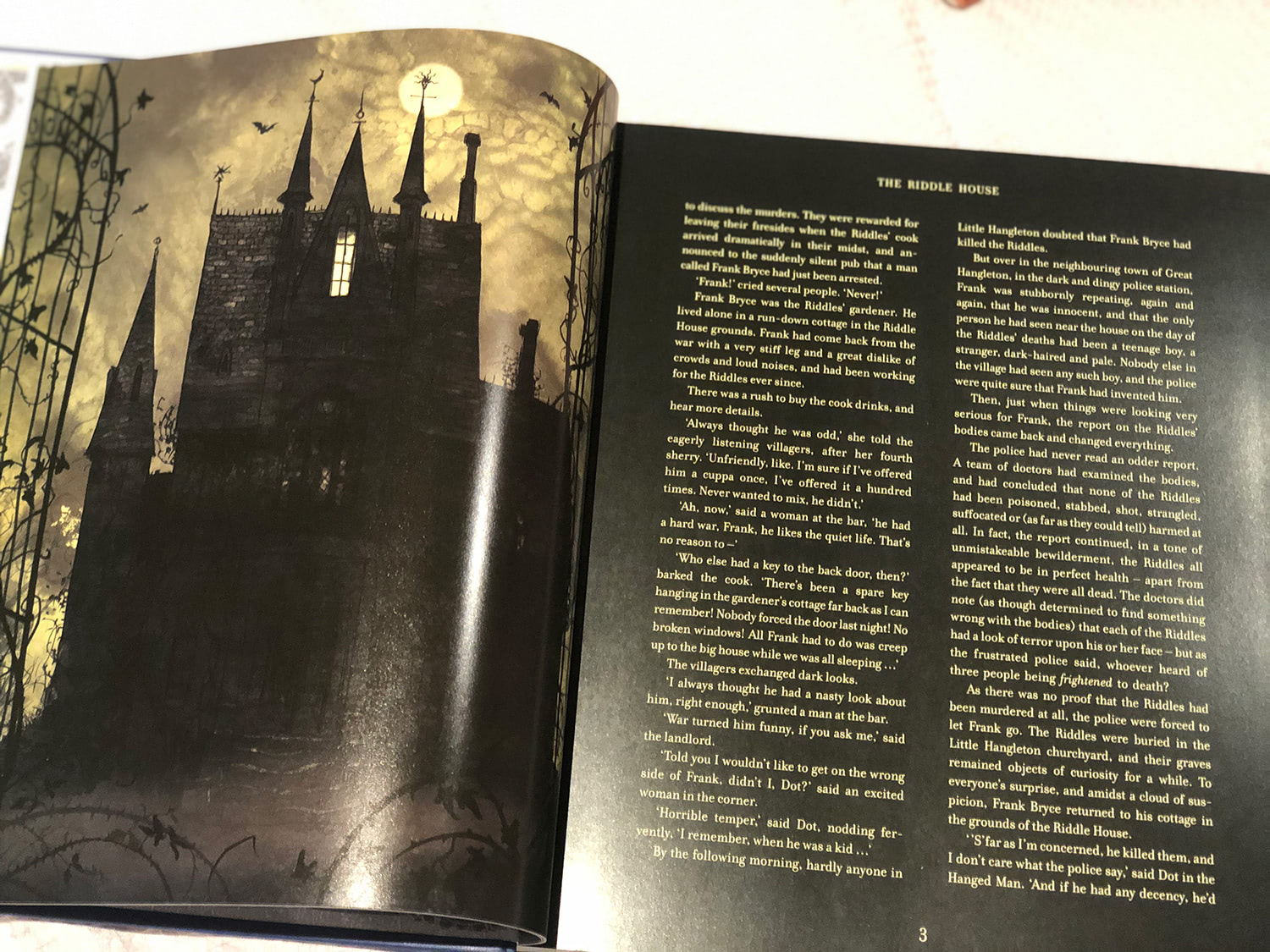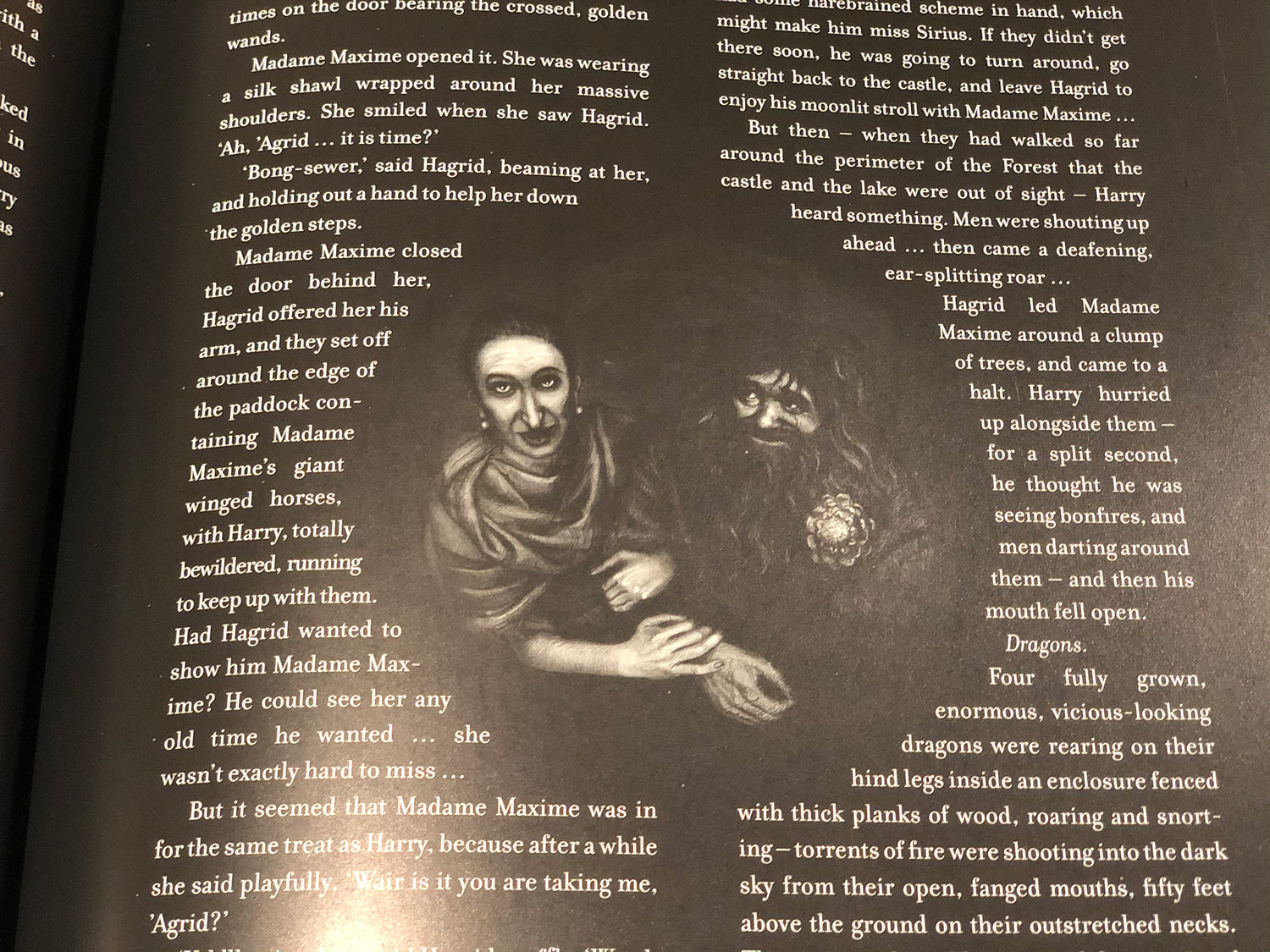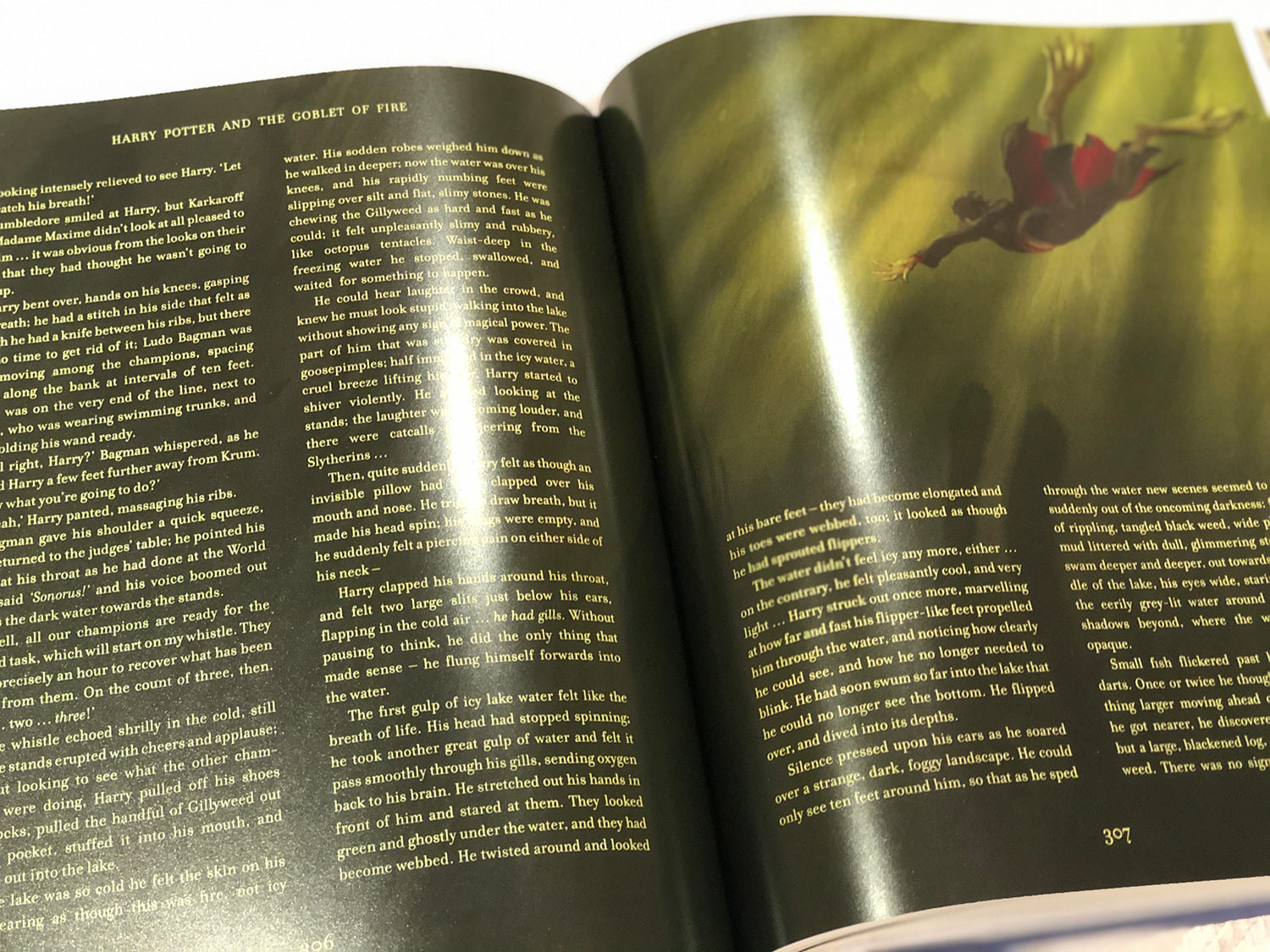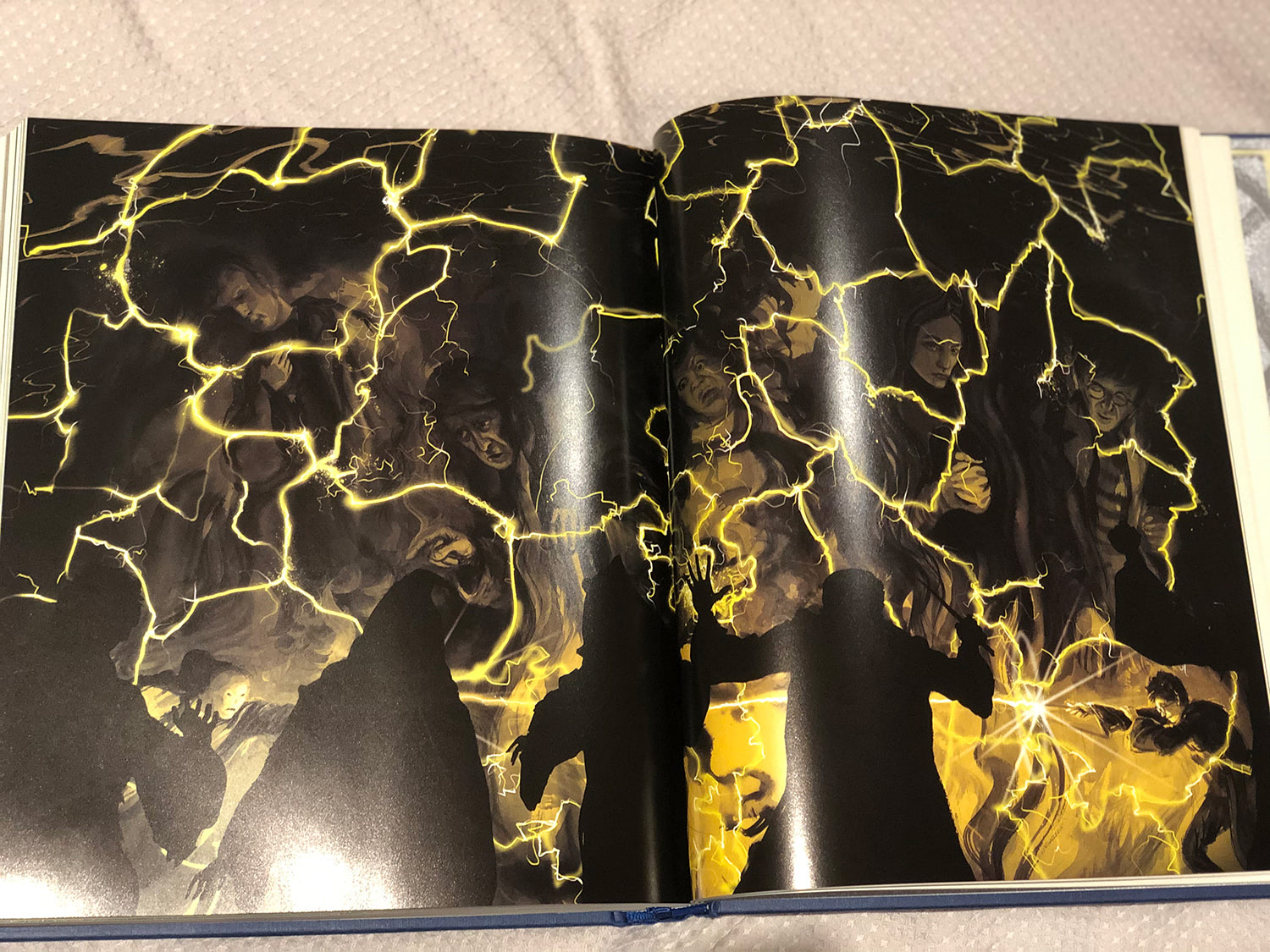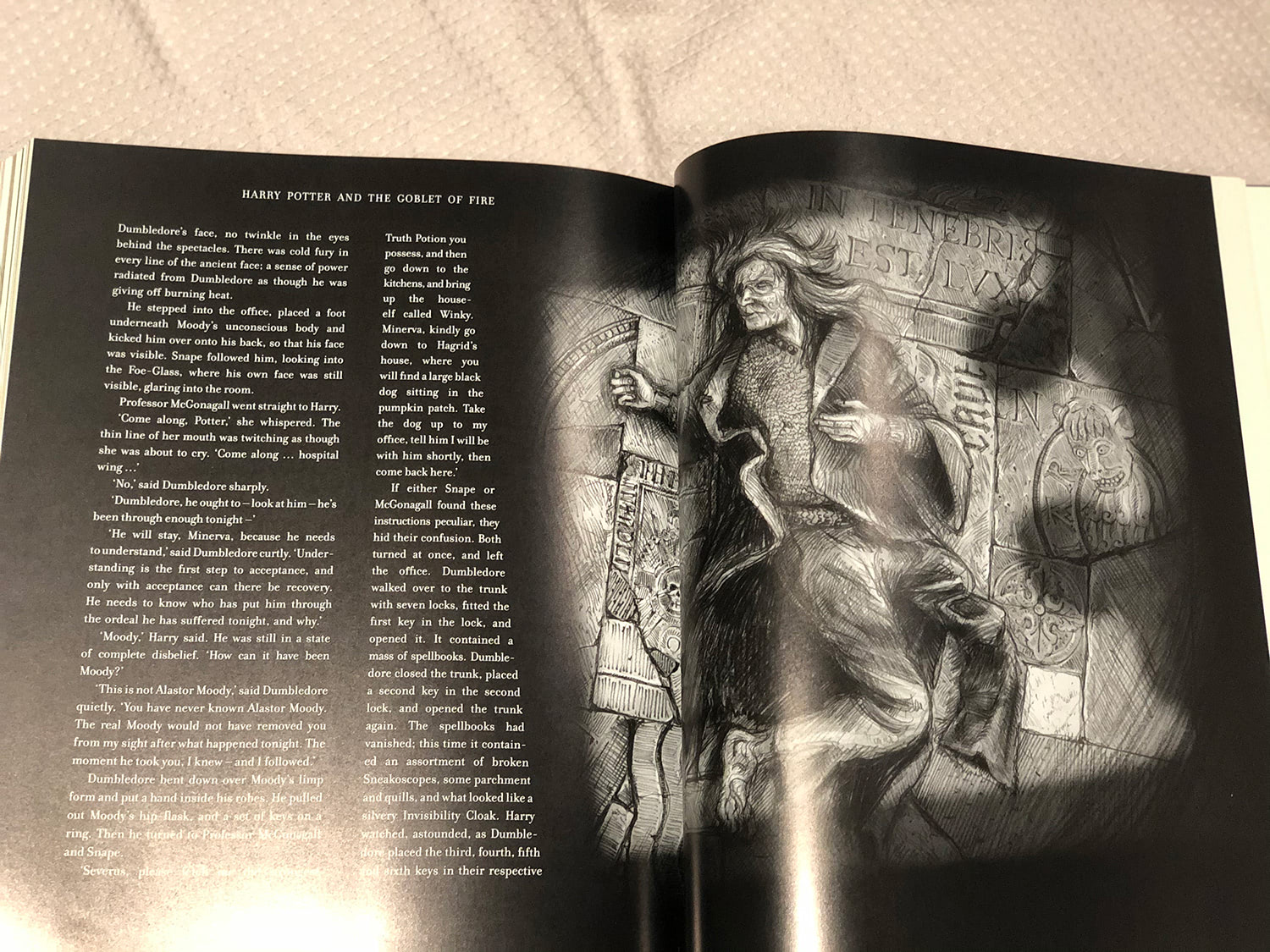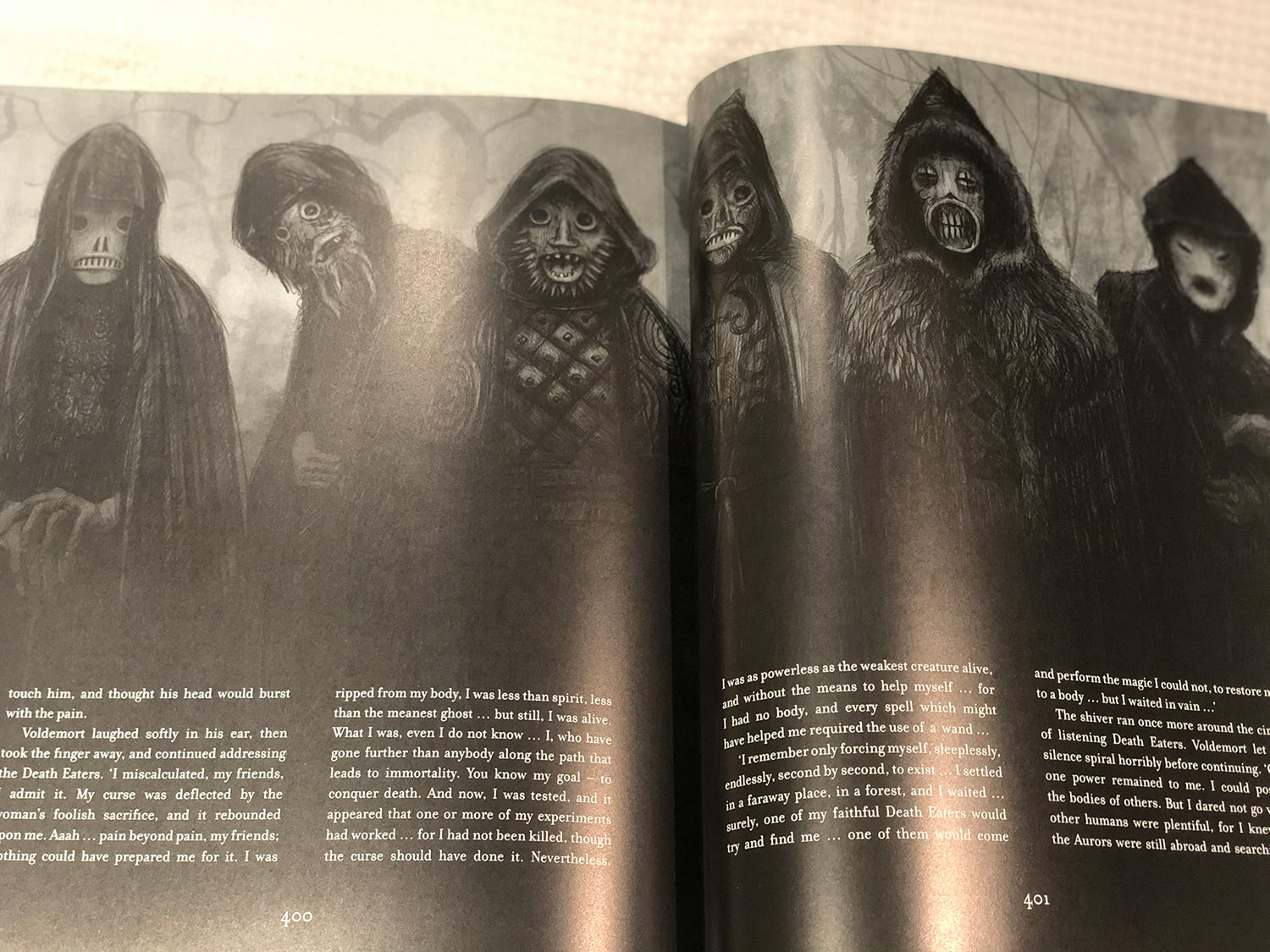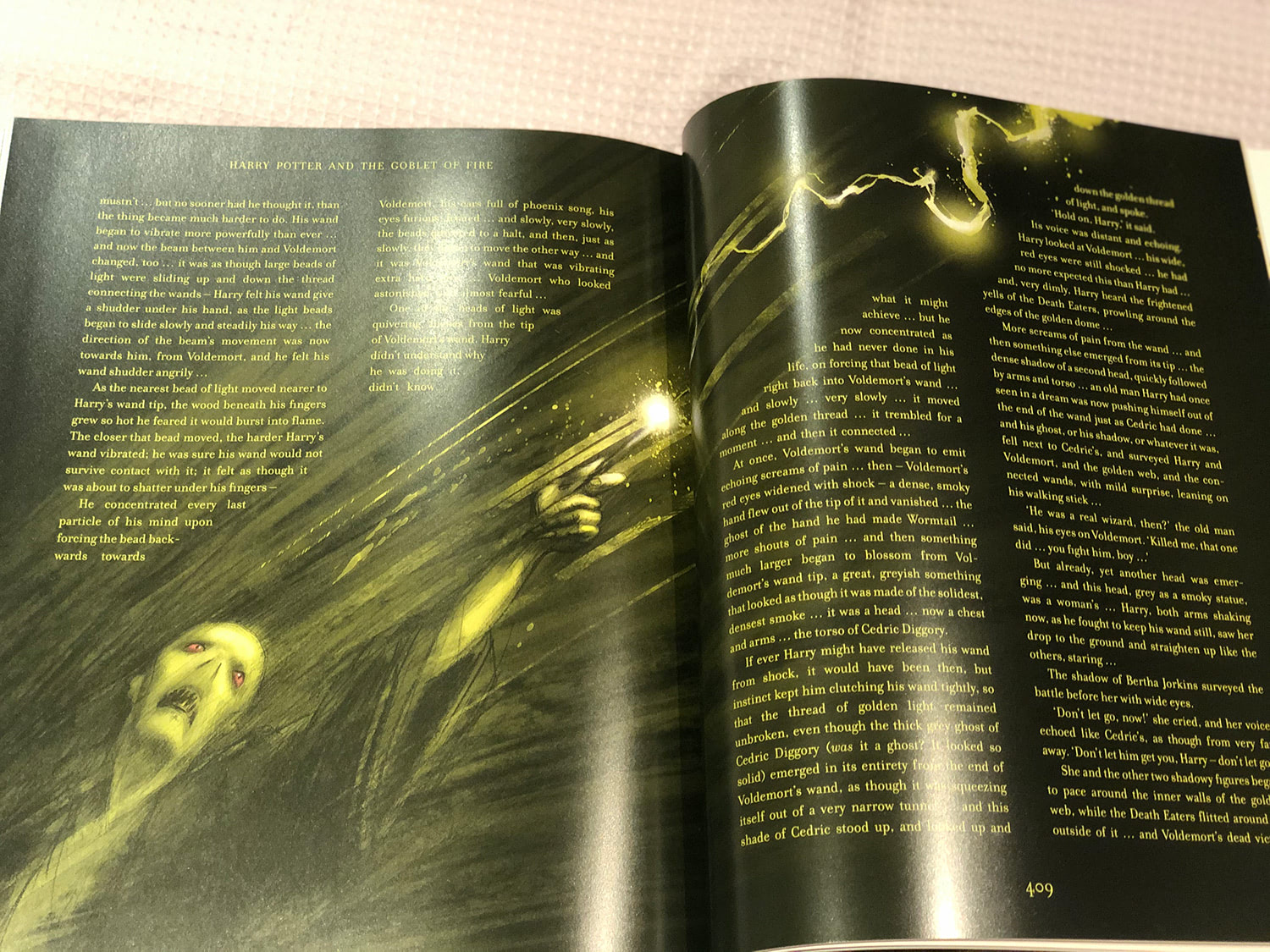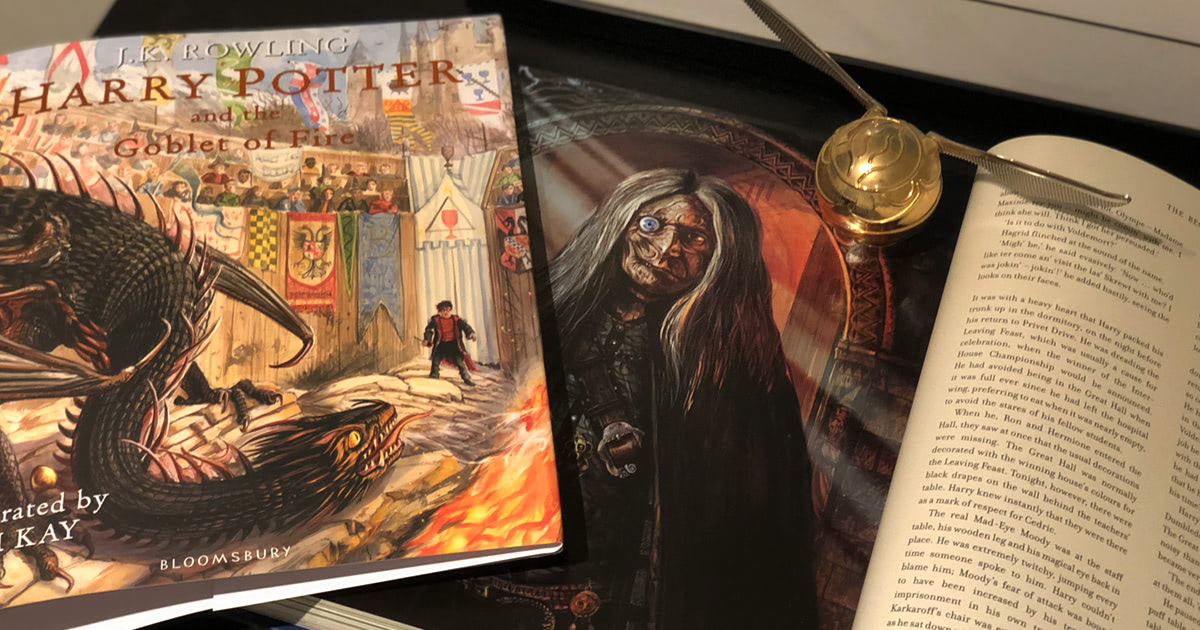
It’s been 735 days since the last Harry Potter illustrated edition hit shelves — just over two years since illustrator Jim Kay beautifully rendered Harry’s third story with brush and ink. And while two years seems an excruciatingly long time between Butterbeers, Kay was justifiably given the time needed to complete a task of Triwizard proportions: translating J.K. Rowling’s fourth and second-largest ‘Potter’ novel, Goblet of Fire, into an illustrated tome. With over 115 new illustrations, it’s Kay’s finest Wizarding World contribution to date.
Back in late 2013, publisher Bloomsbury announced their intention to republish the seven Harry Potter books with immersive full-colour portraits of characters, scenes and locations to complement Rowling’s now-famous words. Kate Greenaway Medal winner Jim Kay is the talented mixed-media illustrator awarded that epic and exciting responsibility, and he unveiled the first of his artistic creations, the illustrated edition of Harry Potter and the Philosopher’s Stone, in 2015. Like magic, the artist worked at a staggering pace to illustrate Chamber of Secrets and Prisoner of Azkaban to meet yearly publication deadlines in both 2016 and 2017, respectively.
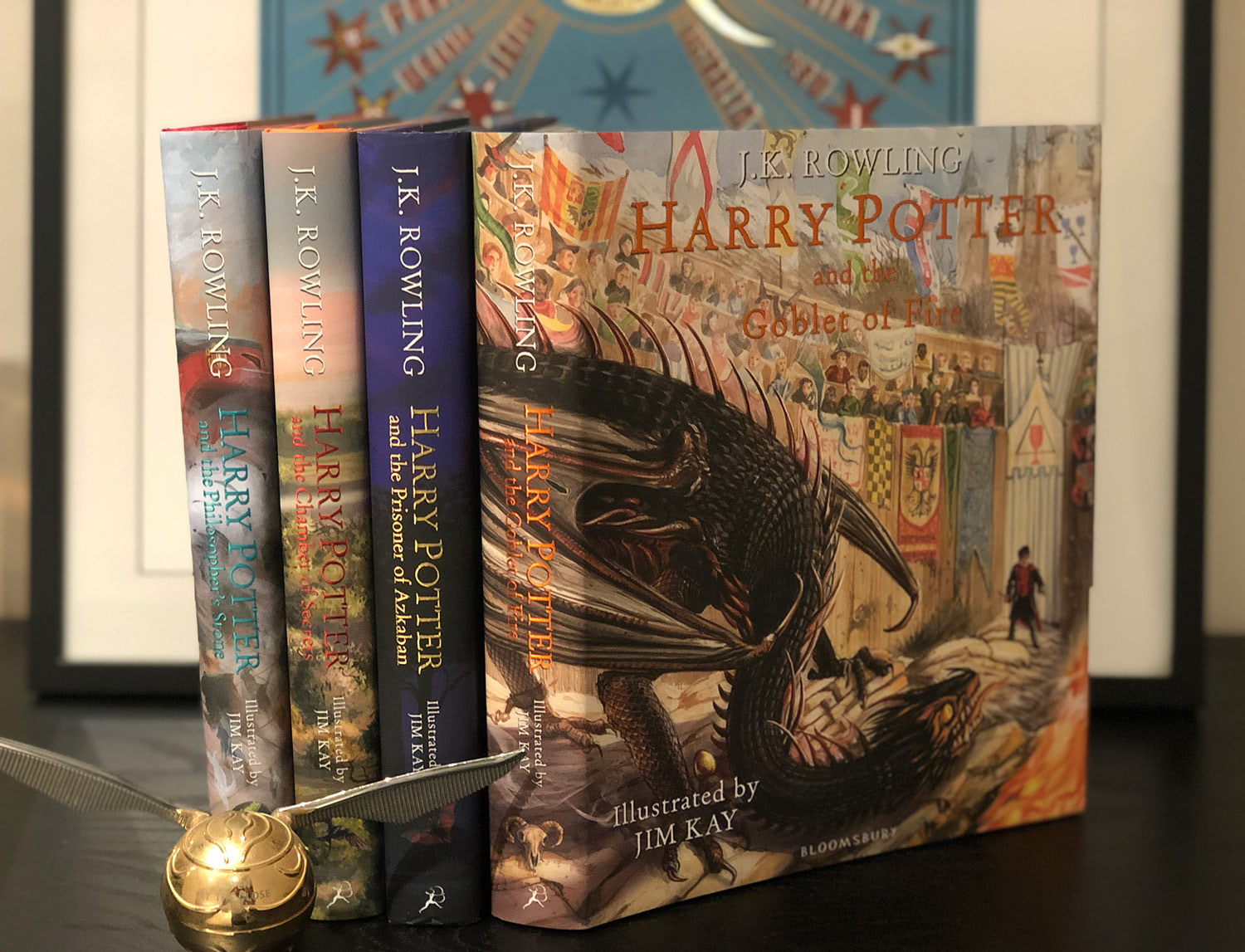
Justifiably, Kay was given an additional year to illustrate 2000’s Goblet of Fire, a novel twice the size of its predecessor and a book that caused Rowling herself much difficulty (working at lightspeed against significant publisher pressure, a plot hole forced the author to rewrite a large proportion of the book). What Rowling eventually produced was a meticulous and comprehensive novel which greatly expanded the Wizarding World: witches and wizards from different nations are introduced, Quidditch goes global and the evil Lord Voldemort rises again. Nearly two decades later, Jim Kay has captured the novel’s darker tone and breathes new colour and life into some of the most memorable scenes and characters in the ‘Potter’ universe.
While anticipating publication, there was a legitimate concern that I’d need to conjure a second bookshelf to accomodate the gargantuan Goblet of Fire release. Surprisingly, the book is only ever so slightly larger than Prisoner of Azkaban. My first impression is that Bloomsbury has achieved this by printing on slightly thinner paper and rendering Rowling’s text with smaller and tighter type. The paper difference isn’t noticeable (it doesn’t feel like you’re going to accidentally tear the thing apart) and the type perfectly readable, so the decision is, I feel, perfectly justifiable given there are three lengthy novels to come (and we don’t all have access to Hermione Granger’s bottomless bag). However, it’s also worth noting that another contributor to the reduced size is — rather disappointingly — three chapters without a single illustration (more on that later).
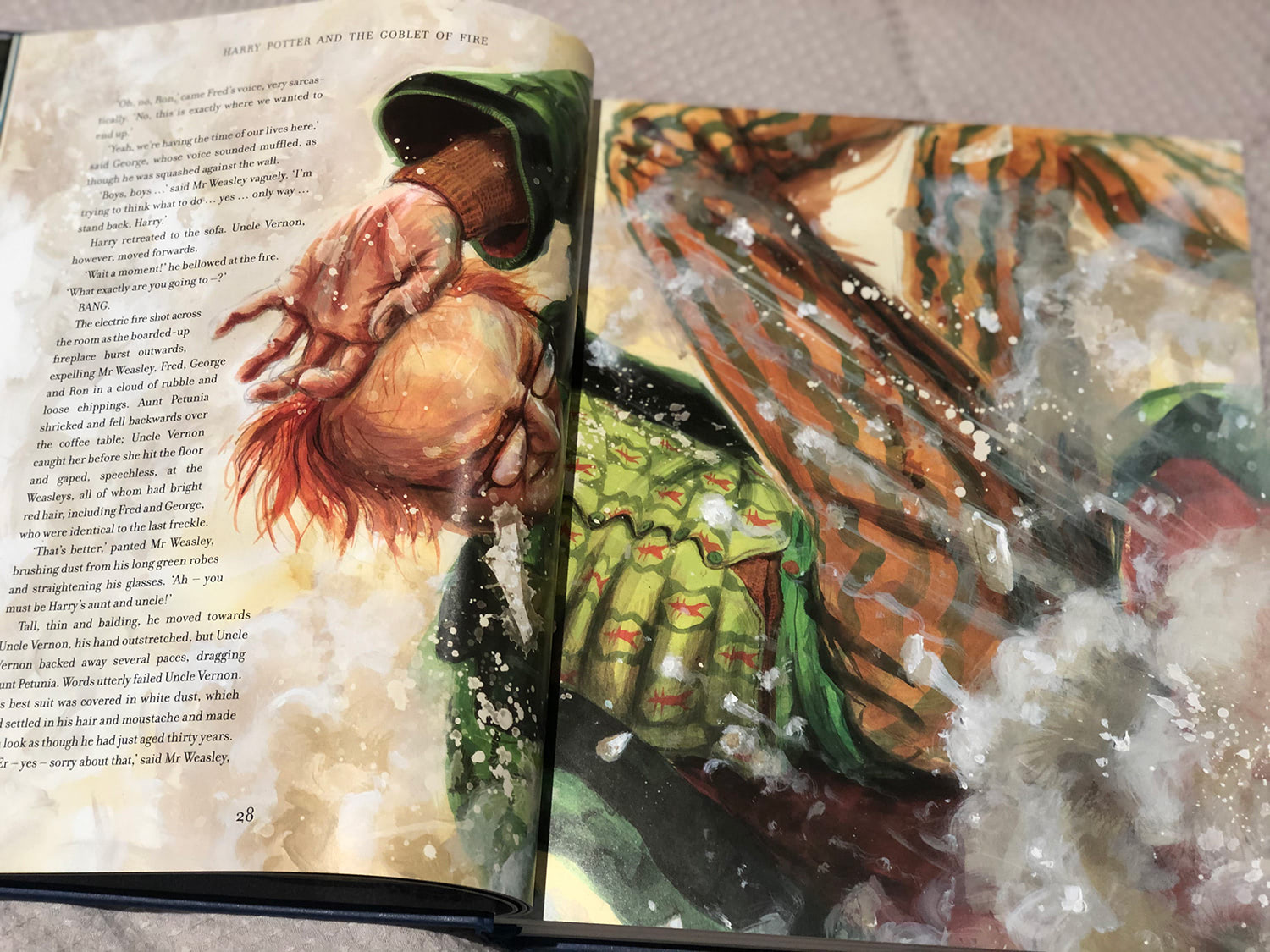
Of course, fans will flock to the Goblet of Fire illustrated edition for the staggering breadth of new artwork which Jim Kay has spent the best part of two years sketching, painting and assembling. Bloomsbury promises over 115 new pieces of artwork from the illustrator and the wealth of new material does not disappoint. Like the three earlier editions, illustrations vary in size, technique and placement; and the balance of illustration and text feels both subtle and, when necessary, bold. Interspersed throughout the book are prominent character portraits (Mad-Eye Moody, Rita Skeeter, Ginny Weasley); full-page paintings (the foreign school arrivals, Priori Incantatem, the Yule Ball); an encyclopaedic exposé (dragons); and small embellishments and decorations nestled amongst text (‘Potter Stinks’ badges, spiders, Weasley sweets). Similarly, the book’s general art direction — stylistic chapter titles and embellished textured page borders — all feel polished.
Goblet of Fire introduces a wealth of new characters and Kay has done a fantastic job of interpreting and merging Rowling’s incredibly descriptive words with his own artistic influences (fun fact: he based Hermione on his niece). Worth mentioning specifically are Kay’s versions of Durmstrang champion Viktor Krum who is much more aligned with the thin, hunched and sallow-skinned character Rowling describes in her books, and the one-eyed and weathered (imposter) Mad-Eye Moody who Kay initially struggled to ensure was not ‘too frightening’. Fleur Delacour and Cedric Diggory are appropriately attractive, while Barty Crouch feels suitably bureaucratic and journalist Rita Skeeter as ‘enchantingly nasty’ as described in the text. To me, Kay’s character illustrations feel like a nice bridge between what’s in my head and what Warner Bros. brought us onscreen — faithful to Rowling’s words and with authenticity and detail the films often gloss over, while still anchored in an established universe.
The full-page illustrative spreads — some of which Bloomsbury shared as part of their pre-release marketing campaign — are where Jim Kay’s incredible artistic talents really shine. The eclectic and pell mell Quidditch World Cup campground is painted with a gorgeous sunrise colour palette (and, undoubtedly, loaded with easter eggs), while Voldemort and Harry’s graveyard wand duel is emblazoned with lightning-like streaks of golden light — an aesthetic that was sorely missing from the 2005 film adaption. The two-page Yule Ball illustration perfectly captures the simultaneous beauty and total awkwardness of that chapter, while pared-back pencil sketches of World Cup spectators and black-and-white illustrations of both Death Eaters and Moody’s unmasking establish striking variety and contrast.
Kay uses contrast most effectively in the novel’s darker chapters where the text and background colours are inverted and illustrations bleed seamlessly into the glossy black paper. This is a technique that I feel was used particularly well in 2016’s Chamber of Secrets, and Jim Kay again uses the combination here to great effect. So striking is the effect that the book actually opens with a chapter told entirely in this style: the mysterious Riddle House and Muggle caretaker Frank Bryce are set against dark vines and shadows for an appropriately creepy aesthetic. The style is again used during Harry’s descent into the underwater Blake Lake and, of course, during Voldemort’s graveyard rebirth.
As the Harry Potter novels became increasingly darker and deviated from their cinematic counterparts (Goblet of Fire the first big example with story omissions), it’s wonderful to see Jim Kay’s rendition of characters and scenes never properly realised on screen. Ludo Bagman is suitably cheerful and chubby, while Winky the house-elf, the elves of the Hogwarts kitchen and the Weasley fireplace fiasco are all given lovely artistic treatment. The addition of Egyptian Quidditch referee Hassan Mostafa adds a nice touch to that chapter, and Kay’s cute illustration of Rita Skeeter as a bespectacled beetle made me smile. As an aside: I do hope future illustrated editions continue to do justice to the wealth of character and location (I’m looking at you St. Mungo’s Hospital and Gaunt family) never given the cinema time they deserved.
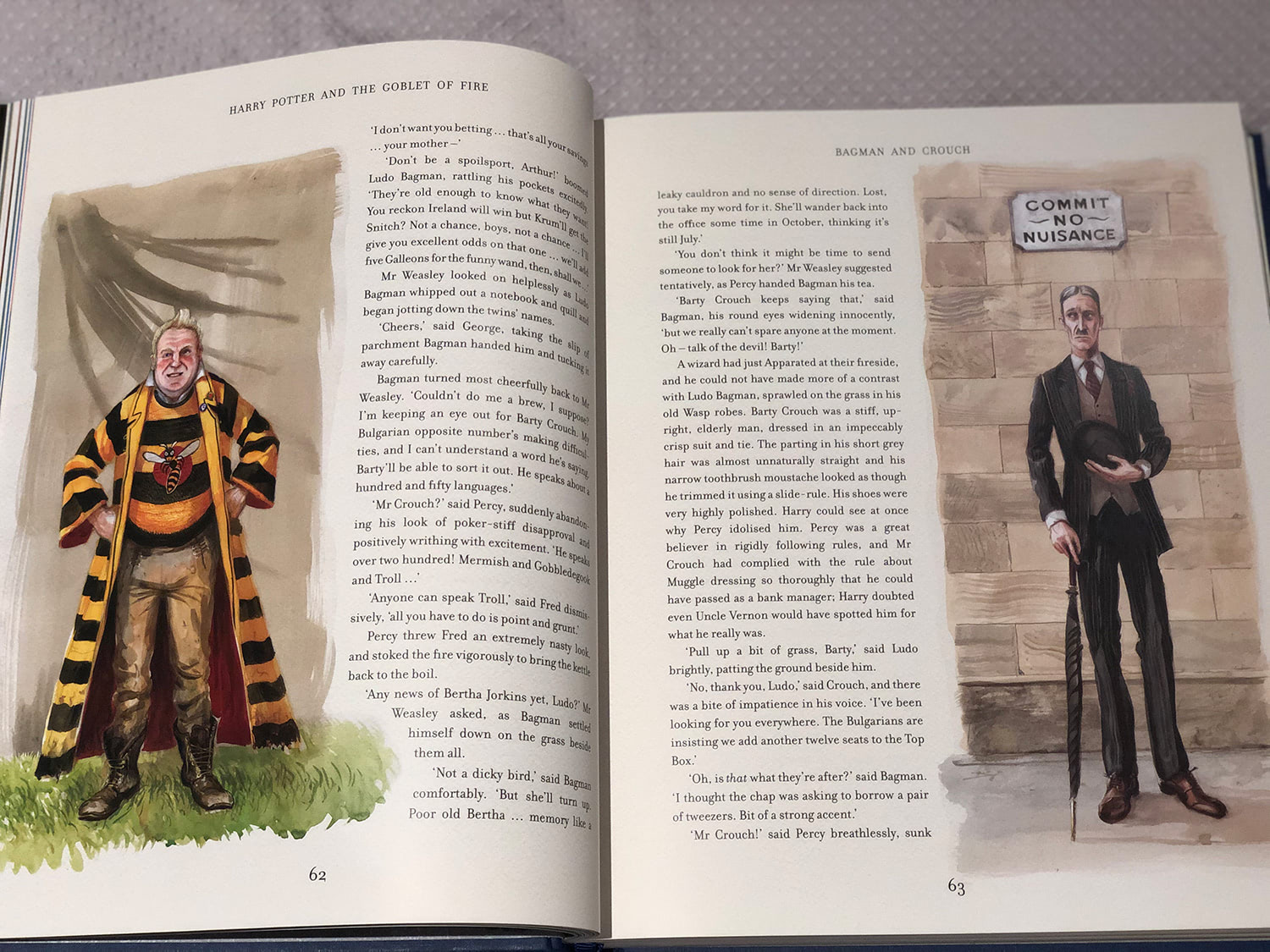
There are few drawbacks in a publication of this magnitude worth mentioning. Undoubtedly, the length and expanse of Rowling’s story (and unavoidable publication pressures) likely determined the final number of illustrations Kay was reasonably able to undertake, as well as those scenes deserving of the most artistic attention. As noted previously, there are three chapters devoid of any artwork. In the Harry Potter film world, Warner Bros. made the decision to cull later-book subplots and storylines less crucial to the main story. There are some parallels in this illustrated edition, where those — I hazard to use the term ‘less interesting’ — chapters are artwork-free. Bloomsbury market these editions as fully-illustrated and immersive reading experiences, and that immersion feels a little broken when you encounter page after page sans-pictures. A couple of small chapter illustrations or tiny artistic accents would certainly have helped to make these conscious omissions less striking.
Similarly, Jim Kay clearly has an affection and affinity for drawing animals. A quick flick through the Goblet of Fire release (and its three predecessors) and Kay’s talent for drawing cats, dogs, dragons and an assortment of creepy crawlies is obvious. And while the artist’s detailed depictions of dragons, Merpeople, Grindylows, spiders and winged horses are nothing short of stunning, I feel the book — like Prisoner of Azkaban before it — relies a little heavily on fauna and decorative flora in favour of some of the human characters and scenes I would have loved to see the artist imagine. Whether or not a conscious decision to leave some key moments to the reader’s imagination, I would have loved to see the Prefects’ Bathroom and courtroom scenes given illustration, likewise neither Cedric, Fleur, Krum, Maxime nor Karkaroff are honoured with portrait-size illustrations.
Minor gripes and personal preferences aside, Jim Kay’s Goblet of Fire illustrated edition is nothing short of a stunning artistic achievement and an absolute must-have for collectors of Rowling’s work. As someone who grew up with the Harry Potter series, seeing Kay reimagine some of my favourite people and places makes me feel incredibly nostalgic. For generations of new fans, experiencing J.K. Rowling’s words alongside equally impressive illustrations must be a wonderful first experience. While there’s likely going to be another lengthy wait for Order of the Phoenix (Instagram tells me Kay is already hard at work illustrating the Thestrals and sickeningly-pink Dolores Umbridge), fans will have to stick by Goblet of Fire a little longer when the 20th anniversary house editions drop in January.
Truly, there’s never been a better time for fans to discover or revisit Rowling’s magic. Thanks to Jim Kay, there’s now an added splash of colour.
***
The Goblet of Fire illustrated edition with artwork by Jim Kay is available in stores and online from today (UK, US). A deluxe slipcase edition is also available.
